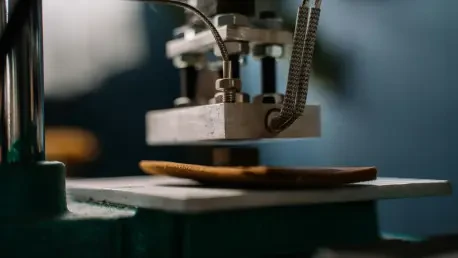Unveiling a Game-Changer in Materials Science
Imagine a world where the metals powering aerospace innovations, nuclear reactors, and semiconductor technologies are not just strong, but precisely engineered at the atomic level to outperform anything seen before. This is no longer a distant dream but a tangible reality, thanks to groundbreaking research emerging from leading academic institutions. A seismic shift is underway in the metals manufacturing sector, driven by the discovery of persistent chemical patterns in conventionally processed alloys. These subtle atomic arrangements, once overlooked, are now recognized as pivotal in enhancing critical properties like mechanical strength, durability, and radiation tolerance. This market analysis delves into the implications of this scientific advancement, exploring how it is reshaping industry trends, influencing demand, and setting the stage for transformative growth across high-stakes sectors. The focus here is on understanding the current landscape and projecting future opportunities for stakeholders eager to capitalize on precision engineering.
Market Dynamics: Trends Reshaping Metals Manufacturing
Atomic Precision as a New Competitive Edge
The metals manufacturing market is witnessing a paradigm shift with the revelation that chemical patterns, or short-range order, persist in alloys even after aggressive production processes. Historically, the industry assumed that intense deformation and heat treatments would randomize atomic structures, rendering such patterns irrelevant. However, cutting-edge simulations have debunked this myth, showing that these arrangements are inherent and significantly impact material performance. For industries like aerospace, where lightweight yet robust materials are paramount, this discovery translates into a competitive edge. Manufacturers who adopt atomic-level design strategies could capture larger market shares by delivering superior products tailored for specific applications, driving a surge in demand for precision-engineered metals.
Dislocations Driving Market Innovation
A deeper dive into the science reveals that dislocations—defects within a metal’s structure—play a selective role in maintaining chemical order by prioritizing weaker bonds during deformation. This non-random behavior results in unique atomic configurations that enhance properties such as catalysis and radiation resistance, critical for sectors like nuclear energy. Market data suggests that companies investing in technologies to map and manipulate these dislocations could see growth rates outpacing competitors stuck in traditional manufacturing paradigms. Early adopters in high-performance markets are already exploring partnerships with research hubs to integrate these findings, signaling a trend toward innovation-driven strategies that could redefine industry standards over the next few years.
Far-From-Equilibrium States Fueling Niche Opportunities
Another emerging trend is the identification of far-from-equilibrium states in manufactured metals, unique atomic arrangements born from specific production conditions. These states, unlike anything observed in natural settings, offer a distinctive fingerprint that can be leveraged for customized material solutions. In the semiconductor industry, for instance, where precise material properties dictate performance, such states could unlock new product categories or improve existing ones. Market projections indicate a growing niche for customized alloys, with potential revenue spikes for firms that master the art of harnessing these non-equilibrium configurations. This trend underscores a broader movement toward specialization, where tailored materials meet the exacting needs of advanced technologies.
Data-Driven Projections: Mapping the Future of Metal Design
Computational Tools Shaping Industry Investments
The integration of advanced computational tools, including machine-learning models and molecular dynamics simulations, is set to revolutionize how the metals market operates. These technologies enable precise mapping of chemical patterns under various manufacturing conditions, providing a predictive framework for optimizing alloy properties. Industry analysis points to a significant uptick in investments toward digital infrastructure, with firms allocating budgets to adopt simulation capabilities. Over the span from 2025 to 2029, spending on such tools is expected to grow at a compound annual rate of over 10%, reflecting confidence in their ability to deliver cost-effective, high-performance materials for demanding applications like aerospace and nuclear energy.
Sector-Specific Growth Forecasts
Breaking down the market by sector, aerospace stands out as a primary beneficiary, with projections estimating a 15% increase in demand for advanced alloys by 2028, driven by the need for stronger, lighter components. Similarly, the nuclear energy sector anticipates a steady rise in adoption of radiation-tolerant metals, with market expansion pegged at 8% annually over the same period. Semiconductor manufacturing, though smaller in volume, shows promise for exponential growth in niche applications, potentially doubling its specialized alloy consumption by the end of the decade. These forecasts highlight a diversified growth pattern, where each sector leverages atomic precision to address unique challenges, collectively pushing the metals market into a new era of innovation.
Economic and Regulatory Impacts on Market Evolution
Economically, the ability to fine-tune metal properties through chemical order offers a pathway to reduced material waste and enhanced durability, translating into cost savings for manufacturers. Regulatory landscapes are also evolving, particularly in nuclear energy, where standards may soon incorporate atomic-level considerations to ensure safety and performance. Market analysts predict that compliance with such regulations could become a differentiator, favoring companies that proactively align with emerging guidelines. This dual impact of economic efficiency and regulatory adaptation is expected to accelerate the shift toward precision manufacturing, reshaping supply chains and influencing pricing strategies across global markets.
Reflecting on a Transformative Era
Looking back, the unveiling of persistent chemical patterns in metals manufacturing marked a turning point for industries reliant on high-performance materials. This scientific breakthrough redefined market dynamics, spotlighting atomic precision as a cornerstone of competitive strategy. The adoption of computational tools and the focus on sector-specific innovations underscored a period of rapid evolution, where traditional assumptions gave way to data-driven design. For stakeholders, the path forward involved strategic investments in technology and partnerships with research entities to stay ahead of the curve. Embracing training initiatives to build expertise in atomic-level engineering also emerged as a priority, ensuring that businesses could translate these insights into practical gains. Ultimately, this era set a precedent for how overlooked phenomena, when revisited with fresh methodologies, could unlock vast potential, urging the industry to continuously innovate and adapt to the hidden intricacies of materials science.









